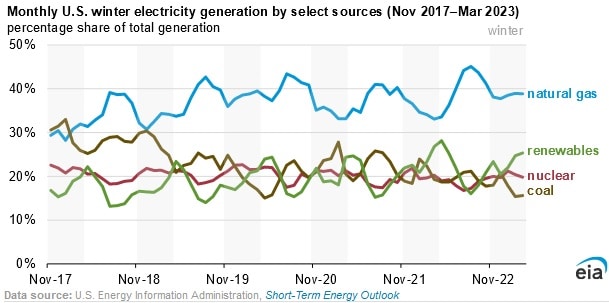U.S. Gas-Fired Power Generation Last Winter Reached Record High: EIA

In the most recent winter heating season during Nov 1–March 31, U.S. electricity generation from natural gas was the highest in over 25 years. Setting a record at 619 billion kilowatt-hours (BkWh), gas-fired generation averaged over 120 BkWh per month and accounted for 38 percent of U.S. power generation mix, according to a June 6 report from the U.S. Energy Information Administration. This remarkable increase can be attributed to rising electricity demand and a continued shift away from coal-based generation.
In a notable trend, U.S. electricity generation this past winter hit its highest level since at least 1997. To meet the increased demand, natural gas, wind, and solar power all saw a rise in electricity generation compared to the previous winter of 2021-22. Conversely, coal-based electricity generation decreased during the same period.
Electricity Demand
According to EIA’s recent short-term energy outlook, U.S. sales of electricity to end consumers are projected to remain relatively stable throughout the forecast period. Anticipated electricity sales during this summer from June-Aug. are slightly lower compared to the previous year, primarily due to a 2 percent decrease in industrial electricity consumption resulting from reduced manufacturing activity.
Electricity Generation
In the U.S., new solar, wind, and nuclear capacity will boost electricity generation this summer. Solar has been the leading source of new generation, with a projected 24 percent increase compared to last summer. Wind generation is expected to grow by 7 percent during the same period.
The addition of a new reactor at the Vogtle nuclear plant in Georgia will result in a 2 percent increase in U.S. nuclear generation this summer compared to last year. Another reactor is anticipated to begin operations at Vogtle in early 2024.
The projected increase in summer generation from solar, wind, and nuclear power will result in a decrease in coal-fired generation. Utility companies have retired approximately 6 percent of coal capacity in the past 12 months, and the remaining coal plants are expected to have lower utilization rates. As a result, U.S. coal-fired generation is expected to decline by 15 percent this summer compared to summer 2022.
Natural gas continues to be the primary source of U.S. electricity generation, and it is expected that natural gas-fired power plants will generate 3 percent more electricity this summer compared to the previous year. This forecast considers the addition of new natural gas-fired generating capacity and the favourable cost of fuel, both of which contribute to the projected increase in summer generation from natural gas.
EnerKnol Pulses like this one are powered by the EnerKnol Platform—the first comprehensive database for real-time energy policy tracking. Sign up for a free trial below for access to key regulatory data and deep industry insights across the energy spectrum.
ACCESS FREE TRIAL